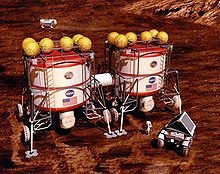


A Mars habitat is a hypothetical place where humans could live on Mars.[2][3] Mars habitats would have to contend with surface conditions that include almost no oxygen in the air, extreme cold, low pressure, and high radiation.[4] Alternatively, the habitat might be placed underground, which helps solve some problems but creates new difficulties.[5]
One challenge is the extreme cost of transporting building materials to the Martian surface, which by the 2010s was estimated to be about US$2 million per brick.[6] While the gravity on Mars is lower than that on Earth, there are stronger solar radiation and temperature cycles, and high internal forces needed for pressurized habitats to contain air.[7]
To contend with these constraints, architects have worked to understand the right balance between in-situ materials and construction, and ex-situ to Mars.[8] For example, one idea is to use the locally available regolith to shield against radiation exposure, and another idea is to use transparent ice to allow non-harmful light to enter the habitat.[8] Mars habitat design can also involve the study of local conditions, including pressures, temperatures, and local materials, especially water.[8]
- ^ "Photo-s89_51054". Spaceflight.nasa.gov. Archived from the original on 2000-03-04. Retrieved 2015-11-08.
- ^ Changela, Hitesh G.; Chatzitheodoridis, Elias; Antunes, Andre; Beaty, David; Bouw, Kristian; Bridges, John C.; Capova, Klara Anna; Cockell, Charles S.; Conley, Catharine A.; Dadachova, Ekaterina; Dallas, Tiffany D. (December 2021). "Mars: new insights and unresolved questions". International Journal of Astrobiology. 20 (6): 394–426. arXiv:2112.00596. Bibcode:2021IJAsB..20..394C. doi:10.1017/S1473550421000276. ISSN 1473-5504. S2CID 244773061.
- ^ "3D-printable ice house could be our home on Mars". cnet.com. September 29, 2015. Retrieved 2015-11-20.
- ^ Fecht, Sarah (2015-09-16). "8 Printable Martian Habitat Designs That We Want To Live In | Popular Science". Popsci.com. Retrieved 2015-11-08.
- ^ Shubber, Kadhim (2013-09-06). "Concept for underground Mars habitat marks dawn of Martian mole-people". Wired UK. Retrieved 2015-11-08.
- ^ "STRUCTURE magazine | Structural Challenges for Space Architecture". www.structuremag.org. Retrieved 2017-12-31.
- ^ "STRUCTURE magazine | Structural Challenges for Space Architecture".
- ^ a b c "Habitat design – Mars ex-situ and in-situ resources utilization" (PDF).